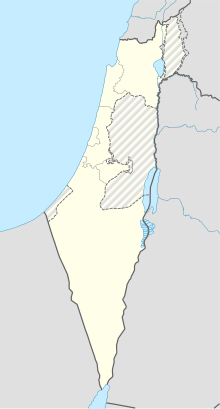Timnah
This article includes a list of general references, but it lacks sufficient corresponding inline citations. (October 2010) |
תל בטש | |
 | |
| Alternative name | תמנתה |
|---|---|
| Location | |
| Area | 10 acre |
| History | |
| Periods | Middle Bronze Age |
| Site notes | |
| Excavation dates | 1979-1990s |
| Archaeologists | Amihai Mazar & George L. Kelm |
Timnath or Timnah was a Philistine city in Canaan that is mentioned in the Hebrew Bible in Judges 14. It has been identified with Tel Batash (Hebrew: תל בטש), a tel located in the Sorek Valley, near moshav Tal Shahar, Israel.
It was uncovered through 1977-1979 by Amihai Mazar and George L. Kelm while Kelm was serving as professor of Biblical Backgrounds and Archaeology at New Orleans Baptist Theological Seminary, on a dig sponsored by the Seminary.[1][2]
The town of Timnath, Colorado in the United States is named for the city.
Geography
The site is strategically located in the Sorek Valley, an access point from the Coastal Plain through the Shephelah and into the Central Judean Mountains. The site is not to be confused with the copper smelting site of Timna in the Arabah near Eilat.
History
The site was first settled in the Middle Bronze Age by creating an earthen rampart that enclosed the 10 acre (4 hectare) site. Excavations under the leadership of Amihai Mazar and George L. Kelm during the 1980s-1990s uncovered twelve strata of continuous settlement at the site through the Hellenistic period, with sparse settlement nearby during the Byzantine period. It included fortifications and buildings from the Kingdom of Judah period, dating to the 7th and 8th Centuries BCE. In one of the buildings, a ceramic potsherd bearing a written LMLK was found. Not far from the tel, on the edge of Nahal Sorek are the remains of a Roman road as well as settlement dating to the Chalcolithic and Canaanite-periods.
Timnah is mentioned in Genesis 38 in the context of the story of Tamar. More important, the city is featured in Judges 14 in the Samson saga. Samson goes to Timnah in order to find a wife. On his way there, he rends a lion. Samson marries a "girl of the Philistines" from Timnah. In Joshua 15:10, the city is mentioned describing the borders of the Tribe of Judah.
References
Other References
- George L. Kelm; Amihay Mazar (December 1995). Timnah: a biblical city in the Sorek Valley. Eisenbrauns. ISBN 978-0-931464-97-3. Retrieved 19 October 2010.
- Eerdmans Dictionary of the Bible. Amsterdam University Press. 31 December 2000. p. 1312. ISBN 978-90-5356-503-2. Retrieved 27 October 2010.
- Avraham Negev; Shimon Gibson (July 2005). Archaeological encyclopedia of the Holy Land. Continuum International Publishing Group. p. 509. ISBN 978-0-8264-8571-7. Retrieved 27 October 2010.
- John Charles Hugh Laughlin (2006). Fifty major cities of the Bible: from Dan to Beersheba. Routledge. pp. 226–. ISBN 978-0-415-22315-7. Retrieved 27 October 2010.
- Lester L. Grabbe (2003). "Like a bird in a cage": the invasion of Sennacherib in 701 BCE. Continuum International Publishing Group. p. 12. ISBN 978-0-8264-6215-2. Retrieved 27 October 2010.
- Jonathan Michael Golden (November 2004). Ancient Canaan and Israel: new perspectives. ABC-CLIO. pp. 70–71. ISBN 978-1-57607-897-6. Retrieved 27 October 2010.
- Hebrew Bible cities
- Former populated places in Southwest Asia
- Archaeological sites in Israel
- Ancient Israel and Judah
- Former populated places in Israel
- Ancient sites in Israel
- Bronze Age sites in Israel
- Iron Age sites in Israel
- Canaanite cities
- Israel geography stubs
- Hebrew Bible stubs
- Near East archaeology stubs
- Israel stubs

